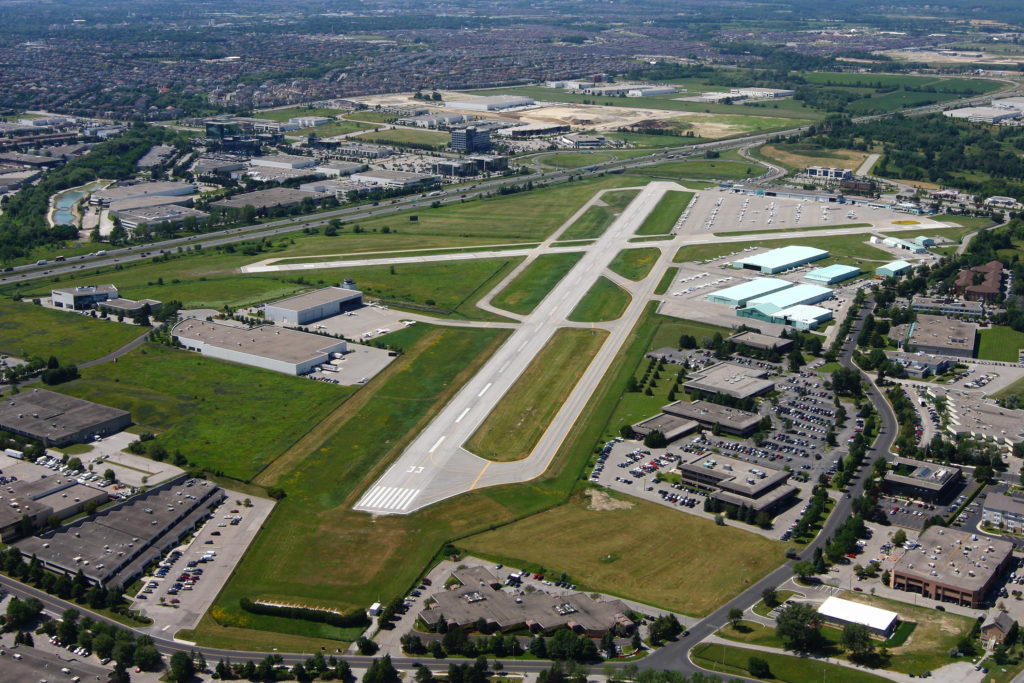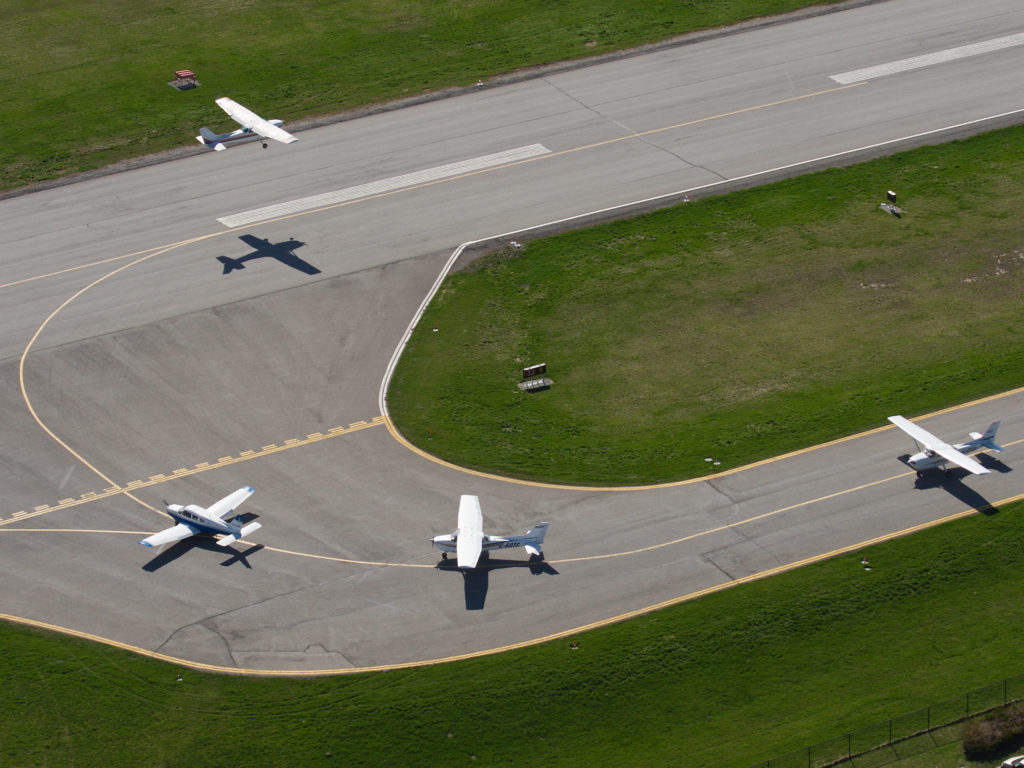Estimated reading time 11 minutes, 11 seconds.
To Nav Canada, there just isn’t enough flying at Toronto Buttonville Municipal Airport (CYKZ) to justify the continued operation of an air traffic control tower and a contract weather office.

Both are set to close on Jan. 3, 2019 — but airport stakeholders aren’t letting go of the service without a fight.
The Markham, Ont., facility — located smack dab in the middle of Canada’s largest metropolis — is privately owned and funded by Torontair Ltd., whose fixed-base operation Million Air Toronto oversees its daily operation.
In its heyday, Buttonville airport was a hotbed of activity. According to Statistics Canada data, it logged a total of 122,386 local and itinerant movements in 2013. That made it the 12th busiest airport in Canada that year when ranked by aircraft movements.
But even then, there was an exodus in the making.
Three years earlier, in 2010, it had been announced that mega developer Cadillac Fairview had purchased the airport lands with the intention of creating a “town within a city.”
Plans called for the airport to be closed within five years.
Airport tenants, including Seneca College, whose aviation program was based at Buttonville, began to leave the airport for new homes. The facility was operating on borrowed time.
“We were in wind-down mode,” said Robert Seaman, Torontair’s vice-president of airport operations.
Aeronautical study
By the spring of 2017, the airport still had not closed. Nav Canada launched an aeronautical study to determine whether a control tower was still needed; by the end of that year, total annual aircraft movements had dwindled to just 26,108.
But numbers aren’t the only consideration, according to Nav Canada spokesperson Ron Singer, who was quoted by the CBC in May 2018 as saying that airports require 60,000 takeoffs and landings per year in order to have a control tower.
“There’s no single metric to determine whether a tower is needed,” he told Skies. “Certainly the traffic volume is one thing, but also the traffic complexity. We note that the traffic at Buttonville is almost all VFR single-engine, fixed-wing traffic.

“I know in the summer of 2017, there was an increase in business jet traffic at Buttonville, but a lot of that had to do with the runway construction at Pearson. We did an analysis and a lot of that was temporary.”
Singer said the aeronautical study, which wrapped up in October 2017, concluded “there would be no increase to aviation safety risk if there was no tower there.”
The report was approved by Transport Canada, as the safety regulator, early in 2018.
A decision was made to close the control tower and weather office in July.
Then, the Cadillac Fairview development stalled. On April 27, 2018, it was announced that the airport would remain open until at least the spring of 2023, “due to significant delays in reaching an appropriate rezoning.”
The guaranteed life extension prompted Torontair to invest more than $1 million into much-needed infrastructure, including plumbing, heating, air conditioning, and airfield wiring.
Activity began to pick up at the airport. Singer acknowledged the numbers have come up, and estimated the airport will see about 40,000 takeoffs and landings by the end of this year, excluding the tower’s handling of overflights, which do not land at the airport.
Safety concerns
Torontair has been vocal about its opposition to closure of the tower and weather office.
“We’ve been fighting this since early in the year, when they said they were going to close [in July],” said Seaman.
Torontair challenged Nav Canada’s decision to close the tower in court, saying it would compromise aviation safety.
Prompted by concerns voiced by stakeholders, “we delayed the closure and went back to do a further analysis,” said Singer.
Nav Canada reduced the tower’s operating hours to 8 a.m. to 8 p.m., effective July 19; and then cut them again in early October to 8 a.m. to 5 p.m.
By Oct. 10, it delivered the news airport users didn’t want to hear: the control tower and airport weather service would be closed on Jan. 3, 2019.
Although the air navigation services provider said it was possible the tower could be re-opened if traffic picks up, Seaman believes the service will be almost impossible to regain once lost.
“They did what we asked: they re-evaluated,” he told Skies. “Their target based on landings and takeoffs says we will come up short of the magical 60,000 number, where they review whether a tower is needed or not.”
However, Seaman and others at the airport argue those numbers should include overflights managed by the tower. “If you add them in, we’re closer than ever [to the 60,000 threshold].”
But for Torontair — and many CYKZ users — the decision to close the control tower and weather office is first and foremost a safety issue.
“As I’ve said many times … This airport is surrounded by the most dense population in all of Canada. It can’t just be about numbers. It’s about safety.”

Situated directly under the approach path to Runway 23 at Pearson International Airport, the maximum altitude for Buttonville airport traffic was recently reduced to 2,000 feet from a previous ceiling of 2,500 feet.
Singer said the change was made to provide a safer level of separation between Buttonville traffic and commercial heavy jets above. The Buttonville tower also handles north-south corridor traffic between the Billy Bishop Toronto City Airport and cottage country.
Seaman disagrees with Singer that airport traffic is largely homogenous.
“Part of our conversation involves the complexity of the movements,” said Seaman. “We’re running medevacs, government, police, media, general aviation, corporate jets. How could you get any more complex? Take away that tower, and it’s going to get risky.”
He added that flight school Canadian Flyers recently started up at the airport, and student pilots benefit from the supervision of an air traffic controller who can help them maintain situational awareness.
Mark Brooks, an experienced 20-year pilot who works as a flight instructor at Canadian Flyers and as an independent freelance pilot, agreed that Buttonville is a unique case and safety is the primary concern.
He, too, cited a mix of traffic–with jets and general aviation aircraft often using both runways at the same time–and the reduced 2,000-foot ceiling, which now restricts airport overflights, as red flags.
“You can’t find another airfield like this anywhere in Canada. There is tremendous potential for an accident here [without an air traffic control tower],” he told Skies. “Now, the tower will often ask aircraft taking off to hold while others land, or tell them to extend their downwind. They are providing safe spacing.”
Without a tower, aircraft enroute to Buttonville would contact the London Flight Information Centre for weather updates all the way in, until switching to a mandatory airfield frequency on approach to landing.
While this works well at smaller airports far removed from complex airspace, Brooks said it poses a hazard at Buttonville.
However, Nav Canada’s Singer countered that at CNC3 in Brampton, Ont.–which he said has almost twice as many annual movements as Buttonville and a similar traffic mix–there is no control tower, “and it’s never been an issue.”
“Taking all of those things into consideration, we concluded that there was no added risk to safety by not providing air traffic control services,” he continued. “We are confident this is not going to have any impact on level of safety. Transport Canada, who carefully reviewed our aeronautical study, agreed with our findings.”
But the debate is far from over.
According to a letter Seaman sent to Nav Canada on Oct. 16, “the absence of a tower will mean not if–but when a significant incident will occur in the skies over and around our airport.”
In the same document, he points out that Nav Canada conceded the tower is already equipped with the necessary infrastructure and systems upgrades to remain in operation, “so the only real cost is manpower.”
He said the airport is willing to work within reduced tower hours and has even offered Nav Canada free rent for both the tower land and the airport weather office.
When asked, Singer said he was not aware of that offer.
“I understand nobody likes to have a change in service, but to suggest that this is being done haphazardly or without a lot of analysis, or that it would be any type of a compromise on safety, is just not right. It’s just not true,” said the Nav Canada spokesperson.
Seaman said airport numbers are on the upswing and he urged Nav Canada to extend the planned closing date by one year to January 2020.
That would buy the airport some time to rebuild its activity to the point where there is no question about the need for a control tower.
“There is no replacement, in my mind, for eyes on the activity here at the airport,” he concluded.
But Singer said the Jan. 3, 2019 closing date is firm.
“If things change in a year from now, well, we’re always evaluating level of service and requirements. But it will take a considerable change in the traffic and traffic patterns and traffic mix to require an air traffic control tower.”
He said there are no plans to further reduce the tower’s operating hours between now and the closing date.









Buttonville Airport could be described as that priceless jewel that has not yet been appreciated for its value. Once it is gone most will say “why did we let that happen!”, but it will unfortunately be too late.
To suggest that aircraft traffic is homogeneous is extremely myopic. News helicopters, air ambulance services, multi-million dollar private jets, flight school aircraft, and others are using the airport daily. During the summer Buttonville is a hub to the north.
Pearson will reach its capacity soon and the Toronto Island airport does not accept jet traffic. The question should not be whether or not to close the Buttonville tower but rather why the Federal government is not or did not consider purchasing and expanding the Buttonville Airport considering Buttonville’s very unique location and potential solution to over capacity at Pearson, and to Buttonville’s contribution to providing safety by its existence.